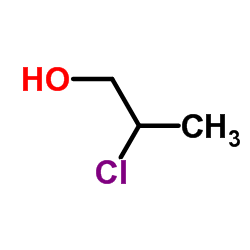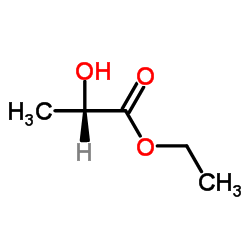37493-14-4
| 中文名 | (R)-(-)-2-氯-1-丙醇 |
|---|---|
| 英文名 | (2R)-2-chloropropan-1-ol |
| 英文别名 |
R(-)-2-chloropropanol
2-Chloropropan-1-ol (R)-2-chloro-propyl alcohol (R)-chloropropanol Propylene chlorohydrin UNII:W3398732C7 (R)-2-chloropropan-1-ol (2R)-2-chloro-1-propanol (R)-(-)-2-Chloropropan-1-ol (R)-(-)-2-Chloro-1-propanol |
| 密度 | 1.1±0.1 g/cm3 |
|---|---|
| 沸点 | 133.5±0.0 °C at 760 mmHg |
| 分子式 | C3H7ClO |
| 分子量 | 94.540 |
| 闪点 | 44.4±0.0 °C |
| 精确质量 | 94.018539 |
| PSA | 20.23000 |
| LogP | 0.27 |
| 外观性状 | 透明无色液体 |
| 蒸汽压 | 3.7±0.5 mmHg at 25°C |
| 折射率 | 1.424 |
| 储存条件 | 密闭于阴凉干燥环境中 |
| 稳定性 | 遵照规定使用和储存则不会分解。 |
| 水溶解性 | 可溶 |
| 分子结构 | 1、 摩尔折射率:22.29 2、 摩尔体积(m3/mol):87.3 3、 等张比容(90.2K):204.0 4、 表面张力(dyne/cm):29.8 5、 极化率(10 -24cm 3):8.83 |
| 计算化学 | 1.疏水参数计算参考值(XlogP):0.6 2.氢键供体数量:1 3.氢键受体数量:1 4.可旋转化学键数量:1 5.互变异构体数量:无 6.拓扑分子极性表面积20.2 7.重原子数量:5 8.表面电荷:0 9.复杂度:22.9 10.同位素原子数量:0 11.确定原子立构中心数量:1 12.不确定原子立构中心数量:0 13.确定化学键立构中心数量:0 14.不确定化学键立构中心数量:0 15.共价键单元数量:1 |
| 更多 | 1. 性状:无可用 2. 密度(g/mL,25/4℃):1.09 3. 相对蒸汽密度(g/mL,空气=1):无可用 4. 熔点(ºC):无可用 5. 沸点(ºC,常压):130 6. 沸点(ºC,5.2kPa):无可用 7. 折射率:1.437-1.439 8. 闪点(ºC):51 9. 比旋光度(º):-17 10. 自燃点或引燃温度(ºC):无可用 11. 蒸气压(kPa,25ºC):无可用 12. 饱和蒸气压(kPa,60ºC):无可用 13. 燃烧热(KJ/mol):无可用 14. 临界温度(ºC):无可用 15. 临界压力(KPa):无可用 16. 油水(辛醇/水)分配系数的对数值:无可用 17. 爆炸上限(%,V/V):无可用 18. 爆炸下限(%,V/V):无可用 19. 溶解性:溶于水。 |
Synonym:None known Section 2 - COMPOSITION, INFORMATION ON INGREDIENTS
Risk Phrases: 10 20/21/22 Section 3 - HAZARDS IDENTIFICATION EMERGENCY OVERVIEW
Flammable. Harmful by inhalation, in contact with skin and if swallowed.The toxicological properties of this material have not been fully investigated. Potential Health Effects Eye: May cause eye irritation. May cause chemical conjunctivitis and corneal damage. Skin: May cause irritation and dermatitis. May cause cyanosis of the extremities. Ingestion: May cause gastrointestinal irritation with nausea, vomiting and diarrhea. The toxicological properties of this substance have not been fully investigated. Ingestion of large amounts may cause CNS depression. Inhalation: The toxicological properties of this substance have not been fully investigated. Aspiration may lead to pulmonary edema. Vapors may cause dizziness or suffocation. May cause burning sensation in the chest. Chronic: No information found. Section 4 - FIRST AID MEASURES Eyes: Flush eyes with plenty of water for at least 15 minutes, occasionally lifting the upper and lower eyelids. Get medical aid. Skin: Get medical aid. Flush skin with plenty of water for at least 15 minutes while removing contaminated clothing and shoes. Wash clothing before reuse. Ingestion: Never give anything by mouth to an unconscious person. Get medical aid. Do NOT induce vomiting. If conscious and alert, rinse mouth and drink 2-4 cupfuls of milk or water. Inhalation: Remove from exposure and move to fresh air immediately. If not breathing, give artificial respiration. If breathing is difficult, give oxygen. Get medical aid. Do NOT use mouth-to-mouth resuscitation. Notes to Physician: Section 5 - FIRE FIGHTING MEASURES General Information: As in any fire, wear a self-contained breathing apparatus in pressure-demand, MSHA/NIOSH (approved or equivalent), and full protective gear. Vapors may form an explosive mixture with air. Vapors can travel to a source of ignition and flash back. During a fire, irritating and highly toxic gases may be generated by thermal decomposition or combustion. Will burn if involved in a fire. Use water spray to keep fire-exposed containers cool. Containers may explode in the heat of a fire. Flammable liquid and vapor. Vapors may be heavier than air. They can spread along the ground and collect in low or confined areas. Extinguishing Media: For small fires, use dry chemical, carbon dioxide, water spray or alcohol-resistant foam. For large fires, use water spray, fog, or alcohol-resistant foam. Use water spray to cool fire-exposed containers. Water may be ineffective. Do NOT use straight streams of water. Section 6 - ACCIDENTAL RELEASE MEASURES General Information: Use proper personal protective equipment as indicated in Section 8. Spills/Leaks: Absorb spill with inert material (e.g. vermiculite, sand or earth), then place in suitable container. Avoid runoff into storm sewers and ditches which lead to waterways. Clean up spills immediately, observing precautions in the Protective Equipment section. Remove all sources of ignition. Use a spark-proof tool. Provide ventilation. A vapor suppressing foam may be used to reduce vapors. Section 7 - HANDLING and STORAGE Handling: Wash thoroughly after handling. Use with adequate ventilation. Ground and bond containers when transferring material. Use spark-proof tools and explosion proof equipment. Avoid contact with eyes, skin, and clothing. Empty containers retain product residue, (liquid and/or vapor), and can be dangerous. Keep container tightly closed. Keep away from heat, sparks and flame. Avoid ingestion and inhalation. Do not pressurize, cut, weld, braze, solder, drill, grind, or expose empty containers to heat, sparks or open flames. Storage: Keep away from heat, sparks, and flame. Keep away from sources of ignition. Store in a tightly closed container. Store in a cool, dry, well-ventilated area away from incompatible substances. Flammables-area. Section 8 - EXPOSURE CONTROLS, PERSONAL PROTECTION Engineering Controls: Facilities storing or utilizing this material should be equipped with an eyewash facility and a safety shower. Use adequate general or local explosion-proof ventilation to keep airborne levels to acceptable levels. Exposure Limits CAS# 37493-14-4: Personal Protective Equipment Eyes: Wear appropriate protective eyeglasses or chemical safety goggles as described by OSHA's eye and face protection regulations in 29 CFR 1910.133 or European Standard EN166. Skin: Wear appropriate protective gloves to prevent skin exposure. Clothing: Wear appropriate protective clothing to prevent skin exposure. Respirators: A respiratory protection program that meets OSHA's 29 CFR 1910.134 and ANSI Z88.2 requirements or European Standard EN 149 must be followed whenever workplace conditions warrant respirator use. Section 9 - PHYSICAL AND CHEMICAL PROPERTIES Physical State: Liquid Color: Clear - clear, colorless Odor: alcohol-like pH: Not available. Vapor Pressure: Not available. Viscosity: Not available. Boiling Point: 124 - 128 deg C @ 760.00mmHg Freezing/Melting Point: Not available. Autoignition Temperature: Not available. Flash Point: 44 deg C ( 111.20 deg F) Explosion Limits, lower: Not available. Explosion Limits, upper: Not available. Decomposition Temperature: Solubility in water: soluble Specific Gravity/Density: 1.0720g/cm3 Molecular Formula: C3H7ClO Molecular Weight: 94.53 Section 10 - STABILITY AND REACTIVITY Chemical Stability: Stable at room temperature in closed containers under normal storage and handling conditions. Conditions to Avoid: Incompatible materials, ignition sources, excess heat. Incompatibilities with Other Materials: Oxidizing agents. Hazardous Decomposition Products: Hydrogen chloride, carbon monoxide, irritating and toxic fumes and gases, carbon dioxide. Hazardous Polymerization: Has not been reported Section 11 - TOXICOLOGICAL INFORMATION RTECS#: CAS# 37493-14-4 unlisted. LD50/LC50: Not available. Carcinogenicity: (R)-(-)-2-Chloropropan-1-ol - Not listed by ACGIH, IARC, or NTP. Section 12 - ECOLOGICAL INFORMATION Section 13 - DISPOSAL CONSIDERATIONS Dispose of in a manner consistent with federal, state, and local regulations. Section 14 - TRANSPORT INFORMATION IATA Shipping Name: PROPYLENE CHLOROHYDRIN Hazard Class: 6.1 (3) UN Number: 2611 Packing Group: II IMO Shipping Name: PROPYLENE CHLOROHYDRIN Hazard Class: 6.1 (3) UN Number: 2611 Packing Group: II RID/ADR Shipping Name: PROPYLENE CHLOROHYDRIN Hazard Class: 6.1 UN Number: 2611 Packing group: II Section 15 - REGULATORY INFORMATION European/International Regulations European Labeling in Accordance with EC Directives Hazard Symbols: XN Risk Phrases: R 10 Flammable. R 20/21/22 Harmful by inhalation, in contact with skin and if swallowed. Safety Phrases: S 9 Keep container in a well-ventilated place. S 16 Keep away from sources of ignition - No smoking. S 23 Do not inhale gas/fumes/vapour/spray. S 28A After contact with skin, wash immediately with plenty of water. S 33 Take precautionary measures against static discharges. S 37 Wear suitable gloves. S 45 In case of accident or if you feel unwell, seek medical advice immediately (show the label where possible). WGK (Water Danger/Protection) CAS# 37493-14-4: No information available. Canada None of the chemicals in this product are listed on the DSL/NDSL list. CAS# 37493-14-4 is not listed on Canada's Ingredient Disclosure List. US FEDERAL TSCA CAS# 37493-14-4 is not listed on the TSCA inventory. It is for research and development use only. SECTION 16 - ADDITIONAL INFORMATION N/A |
|
生态学数据: 该物质对环境可能有危害,对水体应给予特别注意。
|
| 危害码 (欧洲) | Xn: Harmful; |
|---|---|
| 风险声明 (欧洲) | R10;R20/21/22;R36/37/38 |
| 安全声明 (欧洲) | 36/37/39-27-26-16 |
| 危险品运输编码 | UN 2611 |
| WGK德国 | 1 |
| RTECS号 | RA8225000 |
| 海关编码 | 29141990 |
| 上游产品 5 | |
|---|---|
| 下游产品 0 | |
| 海关编码 | 2905590090 |
|---|---|
| 中文概述 | 2905590090 其他无环醇的卤化、磺化等衍生物。监管条件:无。增值税率:17.0%。退税率:9.0%。最惠国关税:5.5%。普通关税:30.0% |
| 申报要素 | 品名, 成分含量, 用途, 包装 |
| Summary | 2905590090 other halogenated, sulphonated, nitrated or nitrosated derivatives of acyclic alcohols。Supervision conditions:None。VAT:17.0%。Tax rebate rate:9.0%。MFN tariff:5.5%。General tariff:30.0% |







